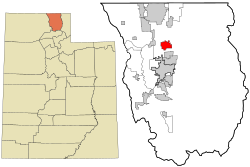Smithfield, Utah
| Smithfield, Utah | |
|---|---|
| City | |
 |
|
| Nickname(s): Smithy | |
| Motto: "Utah's Health City" | |
 Location in Cache County and the state of Utah |
|
| Coordinates: 41°50′7″N 111°49′42″W / 41.83528°N 111.82833°WCoordinates: 41°50′7″N 111°49′42″W / 41.83528°N 111.82833°W | |
| Country | United States |
| State | Utah |
| County | Cache |
| Settled | 1859 |
| Named for | John Glover Smith |
| Area | |
| • Total | 5.0 sq mi (12.9 km2) |
| • Land | 5.0 sq mi (12.9 km2) |
| • Water | 0.0 sq mi (0.0 km2) |
| Elevation | 4,603 ft (1,403 m) |
| Population (2010) | |
| • Total | 9,495 |
| • Estimate (2014) | 11,014 |
| • Density | 2,211/sq mi (853.8/km2) |
| Time zone | Mountain (MST) (UTC-7) |
| • Summer (DST) | MDT (UTC-6) |
| ZIP code | 84335 |
| Area code(s) | 435 |
| FIPS code | 49-69640 |
| GNIS feature ID | 1445709 |
| Website | www |
Smithfield is a city in Cache County, Utah, United States. The population was 9,495 at the 2010 census, with an estimated population of 11,014 in 2014. It is included in the Logan, Utah-Idaho Metropolitan Statistical Area, and is the second largest city in the area after Logan, the county seat. Smithfield is home to Sky View High School, where students from all of northern Cache County come to study.
According to the United States Census Bureau, the city has a total area of 5.0 square miles (12.9 km2), all of it land.
Originally known as "Summit Creek", Smithfield was founded in 1857 by Robert Thornley and his cousin Seth Langdon who were sent north from Salt Lake City by Brigham Young to found a settlement on Summit Creek. After a preliminary scouting, Robert returned with his new wife Annie Brighton. The first winter was spent in a wagon box. By the next summer, with more settlers arriving, a small fort was built on the edge of the creek, one cabin of which remains. As the settlement grew, a bishop was named and the town took his name. By 1917 the town had planted trees on both sides of its Main Street and had acquired a Carnegie library and a Rotary club. Dependent for many years on dairying, a Del Monte canning factory, and the sugar beet industry, the town is now essentially a bedroom community for Logan and its Utah State University.
As of the census of 2000, there were 7,261 people, 2,066 households, and 1,782 families residing in the city. The population density was 1,686.6 people per square mile (650.5/km²). There were 2,159 housing units at an average density of 501.5 per square mile (193.4/km²). The racial makeup of the city was 95.23% White, 0.12% African American, 0.23% Native American, 0.48% Asian, 0.04% Pacific Islander, 2.82% from other races, and 1.06% from two or more races. Hispanic or Latino of any race were 5.04% of the population.
...
Wikipedia
